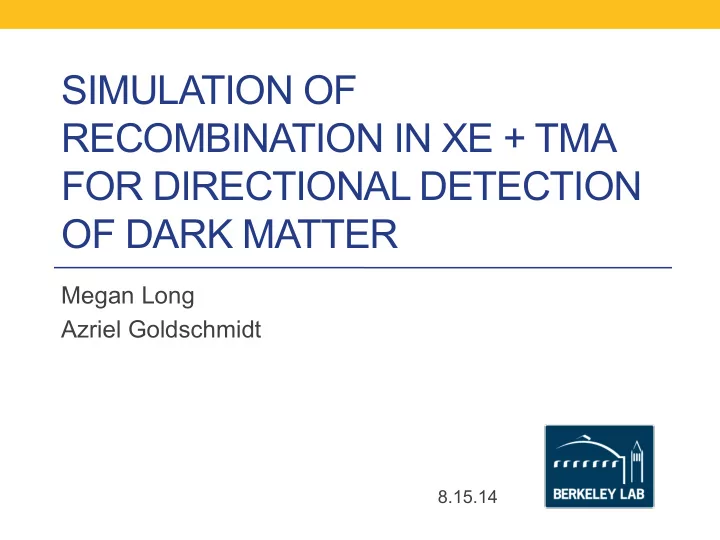

SIMULATION OF RECOMBINATION IN XE + TMA FOR DIRECTIONAL DETECTION OF DARK MATTER Megan Long Azriel Goldschmidt 8.15.14
Simulation Objectives • Quantify electron-ion recombination in xenon gas in Garfield++ in a parallel plate drift chamber • Microphysics simulation – run at NERSC • Multiple electrons tracked at once as a cloud • Model how additives like TMA affect recombination • Investigate possibility of directional detection via columnar recombination • Benchmark simulation against experimental results
Dark Matter & Columnar Recombination When a nuclear recoil is parallel to the electric field, as in Case 1, there will be more electron-ion recombination since the electron passes more ions as it drifts through the chamber.
Current Status • Gets diffusion and drift velocities correct • Aren’t seeing several effects that have been observed in experiment • Looking for a portion of parameter space in which directionality is observed • Run simulations on Carver cluster at the National Energy Research Scientific Computing Center (NERSC) • 400,000 hours used to date • ~100 electrons is maximum can currently simulate at once
Physics of Simulation: Initial Conditions 3D chamber at room temperature parent ion density similar to alpha track: e - 10nm apart at 10 atm +y n total e - Xe + Xe + Xe + Xe + E e - drift e - direction e - e - e - s ‘released’ at 10% of Onsager radius at random initial angle and direction Specify: P, E, gas mix, number of e - , angle of e - line w.r.t. E, runtime
Physics of Simulation: Recombination Total electron energy e - must be negative Xe + Distance to an ion from the electron must be less than either its deBroglie wavelength or the Onsager radius, whichever is smaller • After each step made while cycling through electrons and tracking them using their kinematics, the program checks to see if above recombination conditions have been met.
Current Results: Pure Xenon
Current Results: TMA at 1x ion spacing
Current Results: TMA at 4x ion spacing
Next Steps • Benchmarking the simulation • Angular dependence – run more simulations at different angles • In pure xenon, should see increase in recombination at low fields based on Bolotnikov • Zaragoza’s results with gammas & alphas in Xe + TMA • Possible explanations: • Need to extend the simulated track to compare with actual length of alpha track • TMA energy levels affect recombination near an ion • Combine gamma ray clusters and sections for whole-track recombination estimate • Simulate alpha tracks to use for initial position
Thank you. Questions ?
Recommend
More recommend